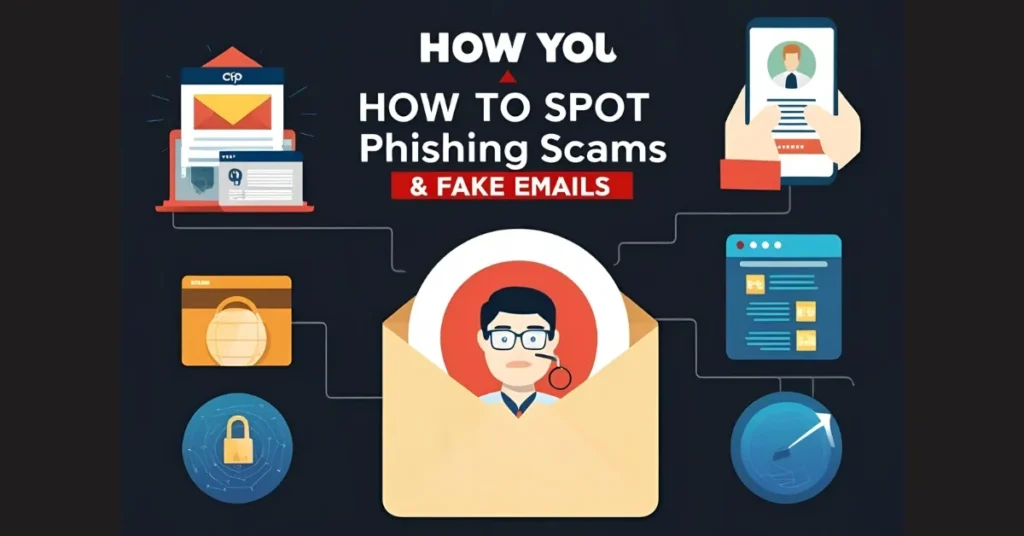You get an email. It looks legit. It’s from your bank, or so it says.
But something feels off. Your gut’s screaming, “Don’t click that link!”
That’s where knowing how to spot phishing scams saves you.
Phishing scams are everywhere – sneaky emails, texts, or even calls trying to steal your money or data.
I’ve been there, staring at a dodgy email, wondering if it’s real.
Let’s break it down so you can dodge these traps like a pro.

What Are Phishing Scams, Anyway?
Phishing is when scammers pretend to be someone you trust – like your bank, PayPal, or even a mate – to trick you into handing over sensitive info.
Think passwords, card details, or your National Insurance number.
They’re not hacking your computer with fancy code.
They’re hacking you – playing on fear, urgency, or trust.
The worst part? They’re getting smarter every day.
Here’s a quick story.
My mate Dave got a text saying his Netflix account was “suspended.”
It had a link to “verify” his details.
He almost clicked it, but the URL looked like it was written by a toddler.
That’s a classic phishing move.
Let’s dive into how you can spot these scams without breaking a sweat.
Why Phishing Scams Are So Dangerous
Phishing isn’t just annoying – it’s a wrecking ball.
One wrong click, and your bank account’s drained, or your identity’s stolen.
In 2023, UK scams cost victims £1.2 billion, with phishing being the top culprit (Action Fraud).
These scams don’t just hit your wallet – they mess with your head.
You feel violated, stupid, angry.
I’ve seen it happen to people who thought they were “too smart” to fall for it.
Nobody’s immune. But you can be prepared.

How to Spot Phishing Scams: 7 Dead-Simple Tips
Let’s cut through the noise.
Here’s how to spot phishing scams without needing a PhD in cybersecurity.
Each tip is battle-tested, and I’m laying it out like I’m explaining it to a friend.
1. Check the Sender’s Email Address
Scammers love faking email addresses.
That “HMRC” email might be from [email protected].
Hover over the sender’s name (don’t click!) to see the real address.
Legit companies use their own domains – like @natwest.com, not @natwest-offers.net.
Example: I got an email from “Amazon Support” once.
Looked real, but the address was [email protected].
Red flag. Bin it.
2. Look for Weird Spelling or Grammar
Big companies don’t send emails with typos like “Ur account is suspendid.”
Scammers often do.
If the email reads like it was written by a bot or someone rushing, it’s probably a scam.
Pro tip: Watch for awkward phrases like “kindly provide your details urgently.”
Real businesses don’t talk like that.
3. Don’t Trust Urgent Threats
Phishing emails love scaring you.
“Your account will be locked in 24 hours!”
“Your payment failed – click here to fix it!”
Legit companies don’t bully you into clicking links.
If it’s urgent, call the company directly using a number from their official website.
Never use the contact details in the email.
Story: My cousin got an email saying her PayPal was “hacked.”
It demanded she log in via a link to “secure” her account.
She called PayPal instead. Guess what? Her account was fine.
The email was pure nonsense.
4. Hover Over Links (But Don’t Click!)
Links are the scammer’s trap.
Hover over any link to see the real URL.
If it’s a jumble of letters or a shortened URL (like bit.ly), steer clear.
Free tool: Use VirusTotal to scan suspicious links before clicking.
It’s quick and catches most dodgy sites.
5. Watch for Generic Greetings
Ever get an email starting with “Dear Customer” or “Hello User”?
Legit companies know your name.
Scammers don’t, so they keep it vague.
If it’s not personalised, it’s a warning sign.
6. Be Wary of Attachments
Got an unexpected PDF or Word doc?
Don’t open it.
Scammers hide malware in attachments to infect your device.
Example: A colleague got an “invoice” PDF from a “supplier.”
It was laced with ransomware.
Always verify with the sender before opening anything.
7. Trust Your Gut
If something feels off, it probably is.
Scammers play on emotions – fear, greed, or curiosity.
Pause. Double-check.
You’re not paranoid; you’re smart.
How to Spot Fake Emails
Fake emails are the backbone of phishing scams.
They’re designed to look real but crumble under scrutiny.
Knowing how to spot fake emails is like having a superpower.
Here’s how to sniff them out fast.
- Inspect the “From” Field Closely: Scammers use lookalike domains (e.g., @paypa1.com instead of @paypal.com).
Always check the full email address, not just the display name. - Look for Subtle Design Flaws: Legit emails have polished logos and layouts.
Fake ones might have blurry images or mismatched fonts.
I once got a “bank” email with a logo that looked like it was drawn in Paint. - Check for Suspicious Requests: Real companies won’t ask for your password or PIN via email.
If they’re begging for sensitive info, it’s a scam. - Use Email Analysers: Tools like MailTester let you verify sender details.
Pop in the email address and see if it’s legit.
Example: I got a “DHL delivery” email with a tracking link.
The logo was off, and the link went to a random .xyz domain.
Deleted it. Later, I checked DHL’s real site – no delivery was even scheduled.

Red Flags for Spotting Phishing Emails, SMS Scams, and Fake Websites
Phishing scams aren’t just emails – they hit you via texts (SMS scams) and fake websites too.
Each has its own red flags.
Here’s how to spot the fakes across all three, so you’re never caught off guard.
Phishing Emails: Key Red Flags
- Spoofed Sender Names: The display name says “HMRC,” but the email’s from a random domain like @tax-refunded.co.ru.
- Overly Pushy Language: Phrases like “Act now or lose access!” scream scam.
Legit companies don’t panic you. - Mismatched URLs: The link says “natwest.com” but points to a shady site like natw3st-login.biz.
- Unexpected Attachments: That “invoice.pdf” you weren’t expecting? It’s probably malware.
- No Personalisation: Generic intros like “Dear Valued Customer” are a dead giveaway.
Story: I got an email from “Apple” claiming my iCloud was full.
It had a button to “upgrade storage.”
The link went to a site with a URL like icl0ud-secure.xyz.
No thanks. Deleted.
SMS Scams: Key Red Flags
- Unknown Numbers: Texts from random numbers, especially international ones, are suspect.
- Shortened URLs: Links like bit.ly or tinyurl hide the real destination.
Never click without checking. - Fake Rewards or Alerts: “You’ve won £500!” or “Your package is stuck!” are classic bait.
- Spammy Grammar: Texts with typos or weird phrasing (e.g., “Ur parcel await’s”) aren’t from legit companies.
- Unprompted Contact: If you didn’t sign up for texts, why are they texting you?
Example: My sister got a text from “Royal Mail” saying her package needed a £2.99 “redelivery fee.”
The link went to a dodgy site asking for her card details.
She checked Royal Mail’s real site – no issues with her delivery.
Fake Websites: Key Red Flags
- Weird URLs: Legit sites use clear domains (e.g., gov.uk).
Scammy ones use gibberish like gov-uk-login.org. - No HTTPS: If the site lacks a padlock or “https://” in the URL, it’s not secure.
- Poor Design: Blurry logos, bad formatting, or broken links scream amateur scam.
- Pushy Pop-Ups: Fake sites often bombard you with “Login now!” or “Claim your prize!” pop-ups.
- Suspicious Forms: If they’re asking for your password, bank details, or PIN, it’s a trap.
Tool Tip: Use Google’s Transparency Report to check if a website’s safe.
It’s free and flags risky sites in seconds.
Example: I clicked a link from a “bank” email (on a test device, don’t worry).
The site looked convincing, but the URL was bank0fengl4nd.co.uk, and it had no HTTPS.
A quick Google Transparency check confirmed it was a scam.
Phishing vs. Legit Emails: A Quick Comparison
| Phishing Email | Legit Email |
|---|---|
| Generic greeting (e.g., “Dear User”) | Personalised (e.g., “Hi, Sarah”) |
| Dodgy email address | Official domain (e.g., @gov.uk) |
| Typos and weird phrasing | Clean, professional language |
| Urgent threats or demands | Calm, clear instructions |
| Suspicious links or attachments | Minimal links, no random attachments |
This table’s your cheat sheet.
Bookmark it. Use it.
It’s saved me from a few close calls.
Free Tools to Stay Safe
You don’t need to pay to protect yourself.
Here are some free tools to help you spot phishing scams, fake emails, SMS scams, and fake websites:
- VirusTotal: Scans links and files for malware.
- Have I Been Pwned: Checks if your email’s been leaked in a data breach.
- PhishTank: A community-driven database of known phishing sites.
- MailTester: Verifies email sender authenticity.
- Google Transparency Report: Flags unsafe websites.
- Your browser’s built-in warnings: Chrome and Firefox flag dodgy sites. Keep them updated.
I use VirusTotal and Google Transparency Report all the time.
They’re like having a scam detector in your pocket.
FAQs About Phishing Scams
Q: How do scammers get my email address or phone number?
They buy leaked data from breaches, scrape websites, or guess common addresses (like [email protected]).
Check Have I Been Pwned to see if your details have been exposed.
Q: Can phishing happen over text or phone?
Yep. Smishing (SMS phishing) and vishing (voice phishing) are real.
Same rules apply – don’t click links or share info with random callers.
Q: What do I do if I clicked a phishing link?
Don’t panic. Change your passwords immediately, enable two-factor authentication, and scan your device with antivirus software like Malwarebytes.
Report it to Action Fraud if you’re in the UK.
Q: Are all phishing emails dangerous?
Not all steal data directly – some just want to spam you.
But why take the risk? If it looks fishy, delete it.
Q: How can I tell if a website is fake?
Check for HTTPS, verify the URL, and look for poor design or suspicious forms.
Use Google Transparency Report to confirm.
Know More
Want to dig deeper? Check these out:
- How to Stay Safe Online
- 10-Step Practical Tips for Staying Safe Online
- Top 10 Best Password Manager 2025
Final Thoughts
Phishing scams are a pain, but spotting them is easier than you think.
You don’t need to be a tech wizard – just stay sharp and trust your instincts.
Next time you get a weird email, text, or stumble on a shady website, run through these tips.
You’ll be laughing at how obvious the scam is.
Stay safe, and keep how to spot phishing scams in your back pocket.
It’s your shield in a world full of digital con artists.

